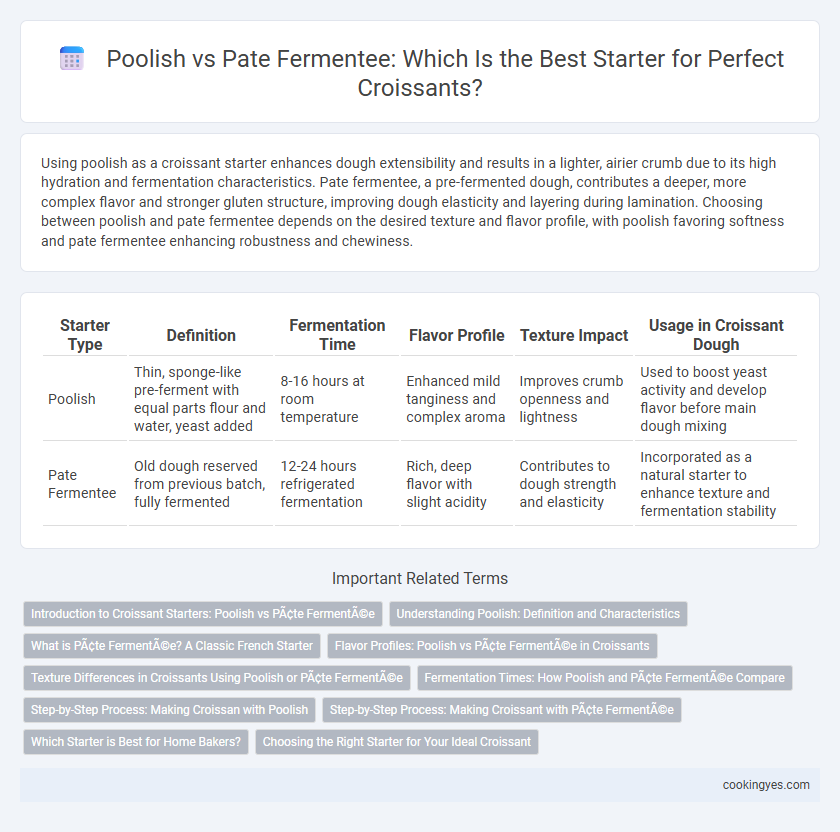Using poolish as a croissant starter enhances dough extensibility and results in a lighter, airier crumb due to its high hydration and fermentation characteristics. Pate fermentee, a pre-fermented dough, contributes a deeper, more complex flavor and stronger gluten structure, improving dough elasticity and layering during lamination. Choosing between poolish and pate fermentee depends on the desired texture and flavor profile, with poolish favoring softness and pate fermentee enhancing robustness and chewiness.
Table of Comparison
| Starter Type | Definition | Fermentation Time | Flavor Profile | Texture Impact | Usage in Croissant Dough |
|---|---|---|---|---|---|
| Poolish | Thin, sponge-like pre-ferment with equal parts flour and water, yeast added | 8-16 hours at room temperature | Enhanced mild tanginess and complex aroma | Improves crumb openness and lightness | Used to boost yeast activity and develop flavor before main dough mixing |
| Pate Fermentee | Old dough reserved from previous batch, fully fermented | 12-24 hours refrigerated fermentation | Rich, deep flavor with slight acidity | Contributes to dough strength and elasticity | Incorporated as a natural starter to enhance texture and fermentation stability |
Introduction to Croissant Starters: Poolish vs Pâte Fermentée
Poolish and pate fermentee are two common croissant starters that impact dough fermentation and flavor development. Poolish is a high-hydration preferment made with equal parts flour and water, promoting faster fermentation and a pronounced tangy aroma. Pate fermentee is a stiff, older dough starter that enhances dough strength and complexity, yielding a more robust crumb structure in croissants.
Understanding Poolish: Definition and Characteristics
Poolish is a type of preferment used in croissant dough, made from equal parts flour and water with a small amount of yeast, creating a highly hydrated sponge. This pre-fermented mixture enhances flavor complexity and dough extensibility, yielding a lighter, airier croissant crumb. The poolish's fermentation time typically ranges from 12 to 16 hours, allowing enzymatic activity to break down starches and develop organic acids that improve taste and dough strength.
What is Pâte Fermentée? A Classic French Starter
Pate fermentee is a traditional French starter made from a portion of old dough reserved from a previous batch, allowing natural fermentation to develop complex flavors and improve dough structure. Unlike poolish, which is a wet pre-ferment made from equal parts flour and water with yeast, pate fermentee contains flour, water, salt, and yeast in proportions similar to the final dough, contributing a more robust, tangy taste to croissants. This classic starter enhances the croissant's crumb texture and extends shelf life by promoting yeast and bacterial activity during the fermentation process.
Flavor Profiles: Poolish vs Pâte Fermentée in Croissants
Poolish starter in croissants enhances acidity and yeast complexity, resulting in a tangier, more aromatic flavor with a slightly open crumb structure. Pate fermentee contributes a milder, buttery taste with a balanced yeastiness and firmer texture, retaining traditional buttery richness. Choosing poolish emphasizes a pronounced sourdough-like tang, while pate fermentee ensures classic croissant flavor with subtle fermentation depth.
Texture Differences in Croissants Using Poolish or Pâte Fermentée
Using poolish as a croissant starter results in a lighter, airier crumb with larger, irregular holes due to its high hydration and extended fermentation time. Pate fermentee produces a denser, more layered texture, enhancing flakiness and providing a rich, buttery mouthfeel from its pre-fermented dough composition. The choice between poolish and pate fermentee directly affects the croissant's structural integrity and mouthfeel, with poolish offering openness and softness, while pate fermentee emphasizes strength and flakiness.
Fermentation Times: How Poolish and Pâte Fermentée Compare
Poolish typically ferments between 12 to 16 hours at room temperature, allowing for extensive enzymatic activity that enhances croissant dough flavor and texture. Pate fermentee undergoes a shorter fermentation of about 2 to 4 hours before refrigeration, providing a more controlled fermentation with less sourness. Comparing these fermentation times, Poolish offers deeper flavor development, while pate fermentee delivers consistency and ease of use in croissant production.
Step-by-Step Process: Making Croissan with Poolish
Creating croissants with a poolish starter involves mixing equal parts flour and water with a small amount of yeast, then fermenting the mixture for 12 to 16 hours until bubbly and aromatic. This pre-ferment enhances dough extensibility and flavor complexity, resulting in a flaky and tender crumb. After incorporating the poolish into the main dough, precise lamination with cold butter layers forms the distinctive airy layers characteristic of classic croissants.
Step-by-Step Process: Making Croissant with Pâte Fermentée
Using pate fermentee as a croissant starter involves incorporating a pre-fermented dough that enhances flavor and texture through a slow fermentation process. First, mix flour, water, salt, and yeast to create the pate fermentee, then let it rest for 12 to 24 hours at room temperature to develop complex flavors. During croissant preparation, this starter is folded into the dough, followed by multiple laminations with butter to achieve the signature flakiness and rich buttery layers.
Which Starter is Best for Home Bakers?
Poolish provides a wetter, more extensible dough starter that promotes a delicate crumb and rich flavor in croissants, making it ideal for home bakers seeking a reliable and simple fermentation method. Pate fermentee, being a stiffer, pre-fermented dough, adds complexity and depth to the croissant's taste but requires more skill and timing, which may challenge beginners. For most home bakers, poolish offers a balanced combination of ease and enhanced flavor that elevates croissant quality without demanding advanced techniques.
Choosing the Right Starter for Your Ideal Croissant
Poolish starter provides a lighter, airier crumb with a more pronounced sourdough tang, enhancing the croissant's flavor complexity through extended fermentation. Pate fermentee offers a milder, more balanced taste and a slightly firmer texture by using a pre-fermented dough that integrates more easily into traditional laminated doughs. Selecting Poolish or pate fermentee depends on desired flavor intensity and dough handling preferences, with Poolish excelling in aroma and open crumb, while pate fermentee ensures consistent elasticity and structure.
Poolish vs pâte fermentée for croissant starter Infographic

 cookingyes.com
cookingyes.com